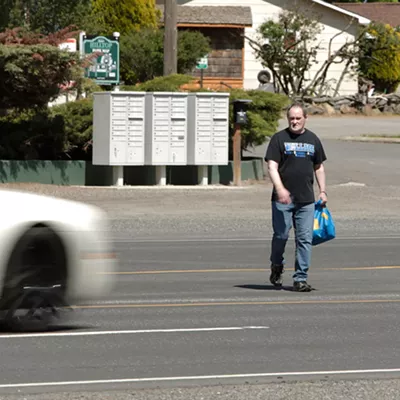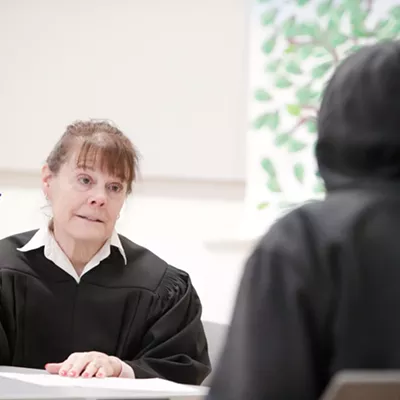
On March 4, 2024, a woman stepped off the sidewalk and onto Sixth Avenue in the Cliff/Cannon neighborhood.
According to a report filed by Spokane's Office of Police Ombuds later that year, the woman said she was smoking a cigarette and wanted to avoid walking too close to a group of children on the sidewalk.
A Spokane police officer happened to be driving down Sixth Avenue toward Oak Street at the same time. The officer stopped his patrol car to engage the woman.
The interaction that ensued resulted in the officer picking the woman up by her waistband and slamming her body onto the pavement. The impact broke the woman's elbow.
The review that followed revealed disagreement between Spokane Police Department trainers, reviewers and administrators on not only whether this use of force was within policy, but whether it was ideal.
A defense tactics trainer on the review board said the officer's actions were completely in line with police training. New Police Chief Kevin Hall disagreed. His leadership team mandated retraining for the officer. Public records requested by the Inlander revealed that the officer involved in the March 4 incident was also involved in an incident in May 2024 where he punched a juvenile in the face.
But the Office of Police Ombuds, a civilian oversight team, didn't pursue either incident as individual misbehavior. Instead, they hammered on the ongoing mishandling of police oversight.
In a closing report this January, the ombuds office gave many recommendations aimed at combating a culture of permissibility and a lack of consistent guidance for use of force review boards.
And so far, the requests have been heard.
The accountability office has essentially no power to force any kind of change within the Spokane Police Department. Police chiefs can either take or leave their suggestions. But Police Ombuds Bart Logue and Deputy Ombuds Luvimae Omana say that Hall has initiated more changes in response to their recommendations than they've ever experienced over the past decade.
"I've seen more change in the last four months than the entire time I've been here," Omana says.
In the eight months he's been on the job, Hall has already clarified policy around use of force and de-escalation. During a previous review board, one reviewer said that anything "up to lethal force can be de-escalation." As of early 2025, it's officially in writing that any use of force is never considered a de-escalation tactic.
Hall is also reconsidering what reviewable uses of force are, so that more cases are reviewed by the chain of command.
Plus, when a promotion opened the spot a few months ago, the chief's team assigned Spokane Police Lt. Sean Wheeler — who has a longstanding, collaborative relationship with the ombuds office and deep experience in Internal Affairs — to take charge of the Spokane police training academy.
"There was an opportunity to take my knowledge and my relationship with the ombuds and plug that into training," Wheeler says. "I mean, we can talk about all the things that we want the officers to do better, but we have to provide them that training."
In his new role, Wheeler also chairs the use of force review boards. He's able to guide them with deep knowledge of the chief's philosophies around force and de-escalation, with heavy input from the ombuds.
"I've not seen this quick of a response to our recommendations in the past," Logue says. "At the end of the day, the police department has to buy in, and they did."
Hall says the Office of Police Ombuds has considerable sway with him, even if they don't always agree.
"They have a lot of influence over me, because I respect them as partners," Hall says. "We're very much aligned on what we want to accomplish here. We both want the most professional, respected police department in the Pacific Northwest."
For Logue, the chief's immediate action and continued willingness to listen is a welcome change — and he hopes it lasts.
"He's bringing his ear to us," Logue says. "It's new and it's good. For now."
CHAIN OF COMMAND
Every use of force triggers some sort of review. Officers write reports after every interaction they have with the public, which immediately go to a supervisor.
But any incident that causes injury triggers a review up the entire chain of command. It ends up with the chief or his designee, usually an assistant chief, who decides whether the incident was within policy and if any discipline needs to take place.
At that point, it also goes before a use of force review board, which is made up of eight to 10 senior officers and a representative from the ombuds office (usually Omana). But since any disciplinary action is already decided without input from the review board, Omana has asked for years what the review board even does.
Instead of asking whether force was in line with policy, Omana has been pushing for the board to ask broader questions like "Was this use of force ideal?" and "Was there something else that could have been better?"
Wheeler, who now chairs the use of force review board, agrees.
"We can be justified in our actions, but if we could take a step back, why not?" Wheeler says. "The end goal is, if we can end this without any force, that's the ideal situation."
When reviewing a use of force, officers should consider factors like imminent danger, the reason for the arrest, and how much force is necessary to overcome resistance.
During the March 4 incident, the subject was resisting arrest by trying to wriggle her hands away from handcuffs while she was pinned to the hood of the police car. She said repeatedly that she didn't know why she was being arrested.
The officer later told the subject's boyfriend that he was citing the woman for pedestrian interference. It wasn't until after she was in cuffs and the officer learned the subject's name and ran it through dispatch that he found out the woman had a felony warrant for trafficking.
Omana questioned whether the reason for the arrest and the amount of resistance merited a hard take down. She also questioned inconsistencies in the officer's report, which described his actions as "guided to the ground," while the Office of Police Ombuds maintains that in a witness's cellphone video footage "it looks more like a wrestling take down."
Reviewers also made a debatable distinction that "the suspect landed on the roadway, which is what caused the injury. The mechanics of the take down did not cause the injury." Omana asked why the officer didn't move the subject to a patch of grass a few steps away.
After the incident, Hall started considering a change to department policy so that all hard takedowns would trigger a chain of command review, regardless of whether the victim was significantly injured.
Omana says multiple reviewers showed general disdain for the administration's decision that the incident violated policy. It started an "impassioned discussion," Omana says, even though the chief's decision brought up the same questions Omana had asked for years.
"For a long time, I felt like I was the only person on this soapbox about, 'What is de-escalation?'" Omana says. "No interaction that I've ever had with these people led me to believe they would take anything I had to say seriously."
Under Hall's leadership, the officers on the review boards have changed. Critical analysis is being encouraged, not squashed. Hall's willingness to listen has ended what Omana describes as years of feeling "gaslit."
"There's just this thing in policing where it's like you have to be a cop for them to really respect your position," Omana says. "All of these changes are because that is what is being communicated from the chief down."
UPON FURTHER REVIEW
According to data from the Spokane Police Department, incidents that involve non-deadly uses of force by police officers are rare. In 2023, 85 of 107,567 interactions with the public involved a use of force — that's just .07% of contacts. In 2024, it was up to .09% — still less than one-tenth of a percent.
These numbers are on the first slide of Spokane Police Capt. Jake Jensen's de-escalation presentation. He usually presents it to officers, but on Friday, April 18, Jensen presented it to members of the Police Ombuds Commission and the Human Rights Commission. The police department invited both organizations to the police academy to talk about officer training.
After offering everyone donuts, Jensen went over the state codes that define the dozen or so complicated factors that could make use of force "objectively reasonable." In a high intensity moment, an officer's split-second decision-making "comes down to how good your training is," Jensen said.
De-escalation tactics are supposed to slow an interaction. They're defined by state law as "actions used by a peace officer that are intended to minimize the likelihood of the need to use force during an incident."
Then, in red underlined font on one of his slides: "Using physical force is not a de-escalation tactic."
Hall and his staff wrote the policy clarification in response to community outcry after the ombuds report revealed that a reviewer said anything up to deadly force could be considered de-escalation, Jensen said.
It's proof that the department is listening to the community, but it's not a major shift in policing mindset — most police officers know that force isn't de-escalation, Jensen said. What the reviewer was trying to get at, Jensen said, is that using less force is better than using more force — that is, using a takedown is better than using a taser, and using a taser is better than using bullets.
The reviewer used the term "de-escalation" sloppily, Jensen said, and it prompted a clarifying discussion of the difference between de-escalation tactics and lower uses of force.
But sloppiness is exactly the kind of fat that Hall wants to trim from his police department. When it comes to implementing policy and cultural changes, Hall says he's pushing for improvement, not punishment.
"There's always been this conversation or question about is it misconduct or is it a mistake?" he says. "I like to add a third one in there — is it mediocrity? Is it just mediocre performance that we need to address? That's what I'm trying to push to the supervisors. A lot of these are preventable if we just have those conversations, have those coaching moments, and say we could have handled this a little bit better." ♦























